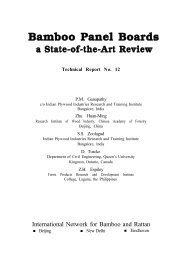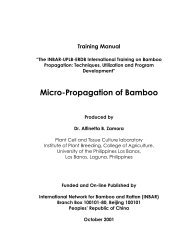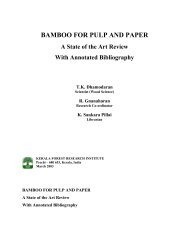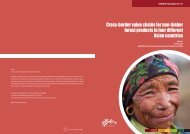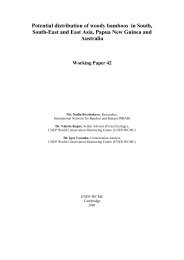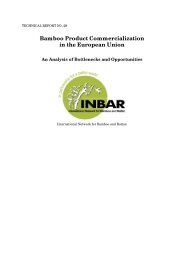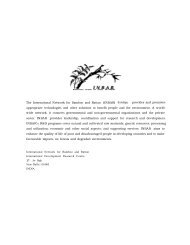The Bamboo and Rattan Sectors in Asia: an Analysis of ... - INBAR
The Bamboo and Rattan Sectors in Asia: an Analysis of ... - INBAR
The Bamboo and Rattan Sectors in Asia: an Analysis of ... - INBAR
Create successful ePaper yourself
Turn your PDF publications into a flip-book with our unique Google optimized e-Paper software.
Constra<strong>in</strong>ts <strong><strong>an</strong>d</strong> opportunities<br />
In this case, government policies have clearly disadv<strong>an</strong>taged the raw material<br />
producers. Policies designed to help the ratt<strong>an</strong> products m<strong>an</strong>ufactur<strong>in</strong>g <strong>in</strong>dustry ---<strong>in</strong>clud<strong>in</strong>g<br />
export restrictions on raw ratt<strong>an</strong>, semi-processed ratt<strong>an</strong>, <strong><strong>an</strong>d</strong> even on f<strong>in</strong>ished<br />
products ---- have reduced the dem<strong><strong>an</strong>d</strong> <strong><strong>an</strong>d</strong> consequently the market price for the<br />
ratt<strong>an</strong> grown <strong>in</strong> the gardens <strong>of</strong> Kalim<strong>an</strong>t<strong>an</strong>.<br />
Moreover, policies <strong>in</strong>tended to help conserve wild ratt<strong>an</strong> resources, such as cutt<strong>in</strong>g<br />
permits <strong><strong>an</strong>d</strong> tr<strong>an</strong>sportation permits, have been equally applied to cultivated ratt<strong>an</strong><br />
also, caus<strong>in</strong>g further disadv<strong>an</strong>tage to the ratt<strong>an</strong> farmers. To a certa<strong>in</strong> extent, the<br />
policies have succeeded <strong>in</strong> terms <strong>of</strong> stimulat<strong>in</strong>g domestic process<strong>in</strong>g capacity, though<br />
raw material production has suffered. In the case <strong>of</strong> the ratt<strong>an</strong> gardens, prices have<br />
dropped below the po<strong>in</strong>t where ratt<strong>an</strong> cultivation is <strong>an</strong> attractive option except <strong>in</strong><br />
areas with very easy access. Even <strong>in</strong> these areas, alternative opportunities (such as oil<br />
palm cultivation) threaten to displace ratt<strong>an</strong> gardens. Yet, the economic <strong><strong>an</strong>d</strong><br />
ecological benefits <strong>of</strong> ratt<strong>an</strong> cultivation with<strong>in</strong> a shift<strong>in</strong>g cultivation system<br />
<strong>in</strong>dicate a need for actions that support ratt<strong>an</strong> cultivation. Also, the ratt<strong>an</strong> products<br />
<strong>in</strong>dustries are very import<strong>an</strong>t <strong>in</strong>come <strong><strong>an</strong>d</strong> employment generators. A sw<strong>in</strong>g too<br />
far <strong>in</strong> terms <strong>of</strong> reduced raw material production could have a devastat<strong>in</strong>g effect<br />
on the <strong>in</strong>dustry.<br />
It will be import<strong>an</strong>t to take steps to <strong>in</strong>crease the barga<strong>in</strong><strong>in</strong>g power <strong>of</strong> the ratt<strong>an</strong><br />
producers, <strong><strong>an</strong>d</strong> to <strong>in</strong>crease the pr<strong>of</strong>itability <strong>of</strong> their enterprise. Some <strong>of</strong> the options<br />
are to:<br />
1. Reduce export taxes/restrictions to open up a larger market for ratt<strong>an</strong>, raw<br />
<strong><strong>an</strong>d</strong> semi-processed;<br />
2. Encourage the formation <strong>of</strong> farmer cooperatives or other collective barga<strong>in</strong><strong>in</strong>g<br />
org<strong>an</strong>izations, which could also serve as the forum for extend<strong>in</strong>g improved technology;<br />
3. Develop <strong><strong>an</strong>d</strong> extend improved cultivation, harvest<strong>in</strong>g <strong><strong>an</strong>d</strong> post-harvest<br />
technologies to <strong>in</strong>crease productivity, reduce costs <strong><strong>an</strong>d</strong> improve the quality <strong>of</strong><br />
cultivated ratt<strong>an</strong>;<br />
4. Select <strong><strong>an</strong>d</strong> improve appropriate large-diameter cluster<strong>in</strong>g ratt<strong>an</strong> species suitable<br />
for small-scale cultivation.<br />
5. Improve the quality <strong><strong>an</strong>d</strong> availability <strong>of</strong> market <strong>in</strong>formation, especially to smallscale<br />
growers <strong><strong>an</strong>d</strong> traders.<br />
19 By Hariyatno Dwiprabowo, Setiasih Iraw<strong>an</strong>ti, Rahayu Supriadi <strong><strong>an</strong>d</strong> B.D. Nasendi (Forest Products<br />
<strong><strong>an</strong>d</strong> Forestry Socio-economic Research <strong><strong>an</strong>d</strong> Development Center, Bogor, Indonesia).<br />
61



